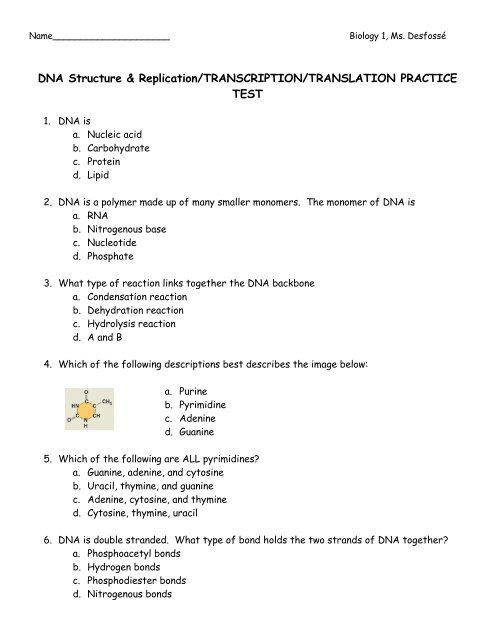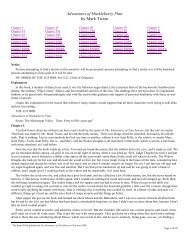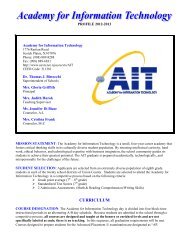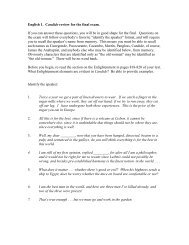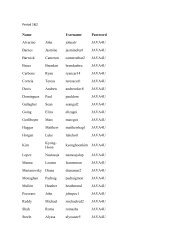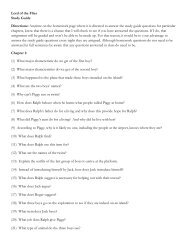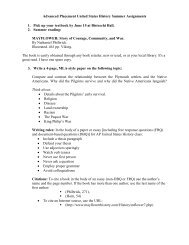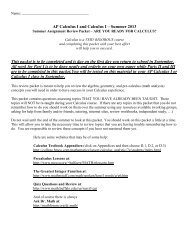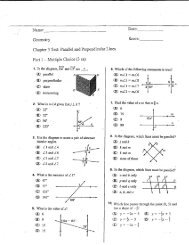DNA Structure & Replication/TRANSCRIPTION/TRANSLATION ...
DNA Structure & Replication/TRANSCRIPTION/TRANSLATION ...
DNA Structure & Replication/TRANSCRIPTION/TRANSLATION ...
Create successful ePaper yourself
Turn your PDF publications into a flip-book with our unique Google optimized e-Paper software.
Name_____________________<br />
Biology 1, Ms. Desfossé<br />
<strong>DNA</strong> <strong>Structure</strong> & <strong>Replication</strong>/<strong>TRANSCRIPTION</strong>/<strong>TRANSLATION</strong> PRACTICE<br />
TEST<br />
1. <strong>DNA</strong> is<br />
a. Nucleic acid<br />
b. Carbohydrate<br />
c. Protein<br />
d. Lipid<br />
2. <strong>DNA</strong> is a polymer made up of many smaller monomers. The monomer of <strong>DNA</strong> is<br />
a. RNA<br />
b. Nitrogenous base<br />
c. Nucleotide<br />
d. Phosphate<br />
3. What type of reaction links together the <strong>DNA</strong> backbone<br />
a. Condensation reaction<br />
b. Dehydration reaction<br />
c. Hydrolysis reaction<br />
d. A and B<br />
4. Which of the following descriptions best describes the image below:<br />
a. Purine<br />
b. Pyrimidine<br />
c. Adenine<br />
d. Guanine<br />
5. Which of the following are ALL pyrimidines?<br />
a. Guanine, adenine, and cytosine<br />
b. Uracil, thymine, and guanine<br />
c. Adenine, cytosine, and thymine<br />
d. Cytosine, thymine, uracil<br />
6. <strong>DNA</strong> is double stranded. What type of bond holds the two strands of <strong>DNA</strong> together?<br />
a. Phosphoacetyl bonds<br />
b. Hydrogen bonds<br />
c. Phosphodiester bonds<br />
d. Nitrogenous bonds
7. Which scientist is responsible for doing the laboratory work (X-ray crystallography) that<br />
led to the discovery of the 3-D structure of <strong>DNA</strong>?<br />
a. Erwin Chargoff<br />
b. James Watson<br />
c. Rosalind Franklin<br />
d. Francis Crick<br />
8. In a <strong>DNA</strong> double helix, a region along one strand of <strong>DNA</strong> has the following sequence:<br />
5’- GCCTAATC-3’<br />
What is the complementary sequence?<br />
a. 3’-GCCTAATC-5’<br />
b. 5’-CGGATTAG-3’<br />
c. 5’-CGGAUUAG-3’<br />
d. 3’-CGGATTAG-5’<br />
9. Look at the following <strong>DNA</strong> strands. Which one is going to be harder to pull apart<br />
(separate the two strands)? Note that only one strand of the doubled stranded <strong>DNA</strong> is<br />
shown. You should be able to extrapolate what the other strand would be.<br />
a. 5’-TTCC-3’<br />
b. 5’-AATC-3’<br />
c. 5’-GGCG-3’<br />
d. 5’-AGCG-3’<br />
10. Look at the following sequence in a nucleic acid: 5’-GCUA-3’ What kind of nucleic acid is<br />
this?<br />
a. <strong>DNA</strong><br />
b. RNA<br />
c. Protein<br />
d. Unable to tell from the information given<br />
11. If a <strong>DNA</strong> molecule contains 40% adenine, what are the percentages of each of the other<br />
nitrogenous bases?<br />
a. 20% cytosine, 20% adenine, 20% guanine<br />
b. 20%thymine, 40% guanine, 40% cytosine<br />
c. 40% thymine, 10% guanine, 10% cytosine<br />
d. 40% uracil, 10% guanine, 10% cytosine
12. Transcription goes from<br />
a. RNA to <strong>DNA</strong><br />
b. <strong>DNA</strong> to <strong>DNA</strong><br />
c. Protein to RNA<br />
d. RNA to protein<br />
e. <strong>DNA</strong> to RNA<br />
13. Translation goes from<br />
a. RNA to <strong>DNA</strong><br />
b. <strong>DNA</strong> to <strong>DNA</strong><br />
c. Protein to RNA<br />
d. RNA to protein<br />
e. <strong>DNA</strong> to RNA<br />
14. For the following <strong>DNA</strong> template strand, what is the mRNA that would be produced?<br />
5’ – CTA TTT CAA CGC TCG GCG TAG CAT- 3’<br />
a. 3’ – GAT AAA GTT GCG AGC CGC ATC GTA – 5’<br />
b. 3’ - CTA TTT CAA CGC TCG GCG TAG CAT – 5’<br />
c. 3’ – GAU AAA GUU GCG AGC CGC AUC GUA – 5’<br />
d. 5’ - GAU AAA GUU GCG AGC CGC AUC GUA – 3’<br />
15. For the following <strong>DNA</strong> template strand, what is the polypeptide that would be produced?<br />
5’ – CTA TTT CAA CGC TCG GCG TAG CAT- 3’<br />
a. Met – Leu – Arg – Arg – Ala – Leu – Lys<br />
b. Asp – Lys – Val – Ala – Thr – Arg – Ile – Val<br />
c. Met – Lys – Arg – Gln – Cys – Leu – His<br />
d. Met – Pro – Trp – Arg – Arg – Phe - Ala<br />
16. What allows us to put <strong>DNA</strong> from one species, like a jellyfish, into another species, like a pig?<br />
a. Pigs and jellyfish have the same genes<br />
b. Pigs and jellyfish make the same proteins<br />
c. The genetic code is universal.<br />
d. All <strong>DNA</strong> is made up of the same components and each codon stands for the same amino<br />
acid regardless of the species.<br />
e. Both C and D
17. In translation, which of the following is responsible for bringing amino acids to the ribosome to<br />
be added to the polypeptide chain?<br />
a. rRNA<br />
b. mRNA<br />
c. tRNA<br />
d. RNA polymerase<br />
e. Large subunit of the ribosome<br />
18. A tRNA has the following anticodon: 3’-GCU-5’. What amino acid does it code for?<br />
a. Ala<br />
b. Arg<br />
c. Ser<br />
d. Leu<br />
e. Phe<br />
19. What amino acid does the “Start tRNA” carry?<br />
a. Ala<br />
b. His<br />
c. Met<br />
d. Trp<br />
e. Phe<br />
20. What kind of bond is formed between amino acids in order to make a polypeptide chain?<br />
a. Phosphodiester bond<br />
b. Peptide bond<br />
c. Hydrogen bond<br />
d. Ionic bond<br />
e. Metallic bond<br />
21. The picture below depicts mRNA being transcribed from a <strong>DNA</strong> molecule. Which <strong>DNA</strong> strand is<br />
the coding strand?<br />
a. The top <strong>DNA</strong> strand<br />
b. The bottom <strong>DNA</strong> strand<br />
c. Both strands are coding<br />
d. Neither strand is coding<br />
e. Unable to determine from the information given
REFERENCE SHEET


